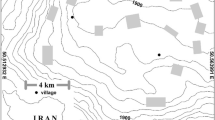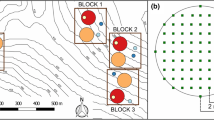Abstract
Resource sharing between tree and forage plant components in silvopastoral systems includes a complex set of facilitative and competitive interactions. To the extent that facilitation exceeds competition, agroforests are expected to outyield monocultures of their components. Pasture and Douglas fir (Pseudotsuga menziesii) tree production of young agroforests was compared to pasture and forest monocultures under both grid and cluster patterns of tree planting near Corvallis, Oregon, USA, during 1983–1987. The height and diameter growth of forest and agroforest trees was similar, regardless of tree planting pattern. Five-year average annual forage production was 6500, 5800, and 2800 kg ha−1 on pasture, agroforest, and forest plots, respectively. The total cumulative 1982–1987 above-ground phytomass yield of forage plus trees was similar for pasture and conventional grid forest monocultures. The total productivity of agroforests, however, was over 30% greater than either pasture or forest components grown in monoculture. Approximately 1.6 ha (0.96 ha forest + 0.64 ha pasture) of monocultures would be needed to equal the productivity of 1 ha of agroforest.
Similar content being viewed by others
References
Anderson GW (1987) Integrated livestock and timber production: beneficial systems in Australia. Agroforestry Consortium Tech Rep 4. Washington State Univ Pullman, USA
Anderson GW and Moore RW (1987) Productivity in the first seven years of a Pinus radiata — annual pasture agroforest in western Australia. Aust J Exp Agr 27: 231–238
Avery M and Gordon J (1983) New frontiers in agroforestry: consequences of pattern in tree and forage systems. In: Hannaway D (ed) Foothills for Food and Forests, pp 261–270. Timber Press, Beaverton, OR, USA
Brown D (1954) Methods of surveying and measuring vegetation. Commonwealth Bureau of Pastures and Field Crops Bull 42. Hurley, UK
Buck MG (1986) Concepts of resource sharing in agroforestry systems. Agrofor Syst 4: 191–203
Carlson DH, Sharrow SH, Emmingham WH and Lavender DP (1994) Plant-soil-water relations in forestry and silvopastoral systems in Oregon. Agrofor Sys 25: 1–12
Gholz HL, Grier CC, Campbell AG and Brown AT (1979) Equations for estimating biomass and leaf area of plants in the Pacific Northwest. For Res Lab, Oregon State Univ, Corvallis Res Rap 41, 37 pp
Hiebsch CK and McCollum RE (1987) The area X equivalency ratio: a method for evaluating the productivity of intercrops. Agron J 79: 15–22
Horwith B (1985) A role for intercropping in modern agriculture. BioScience 35: 286–291
Hunter AF and Aarssen LW (1988) Plants helping plants. BioScience 38: 34–40
Knezevich CA (1975) Soil Survey of Benton County Area, Oregon. USDA, Soil Conserv Serv, Albany, 199 pp
Krueger WC (1981) How a forest affects a forage crop. Rangelands 3: 70–71
Larson FR and Wolters L (1983) Overstory-understory relationships: mixed conifer forests. In: Overstory-Understory Relationships in Western Forests, pp 21–25. USDA For Serv West Reg Res Pub 1
Percival NS and Knowles RL (1986) Relationship between radiata pine and understory pasture production. In: Maclaren (ed) Proc Agrofor Symposium, Tortorua 24–27 November 1986, pp 152–164. For Res Inst Bull 139, Rotorua, New Zealand
Ralph W (1990) Exploring agroforestry in the subtropics. Rural Res 146: 12–15
Sharrow SH (1991) Tree planting pattern effects on forage production in a Douglas fir agroforest. Agrofor Syst 16: 167–175
Sharrow SH (1995) Western Oregon hill land agroforestry: interactions among components. In: Proc 4th North American A Agroforestry Conference: Growing a Sustainable Future. Boise, Idaho, 23–28 July 1995
Sharrow SH, Krueger WC and Thetford of Jr (1981) Effects of stocking rate on sheep and hill pasture performance. J Anim Sci 52: 210–218
Sharrow SH and Tober DA (1979) A simple, lightweight point frame. J Range Manage 32: 75–76
Steel RGD and Torrie JH (1980) Principles and Procedures of Statistics. McGraw-Hill Book Company, New York, 633 pp
Thomas TH (1990) Agroforestry — does it pay? Outlook Agr 19: 161–170
Vandermeer J (1981) The interference production principle: an ecological theory for agriculture. BioScience 31: 361–364
Author information
Authors and Affiliations
Additional information
Oregon Agricultural Experiment Station Technical Paper No. 10, 825.
Rights and permissions
About this article
Cite this article
Sharrow, S.H., Carlson, D.H., Emmingham, W.H. et al. Productivity of two Douglas fir/subclover/sheep agroforests compared to pasture and forest monocultures. Agroforest Syst 34, 305–313 (1996). https://doi.org/10.1007/BF00046930
Issue Date:
DOI: https://doi.org/10.1007/BF00046930




